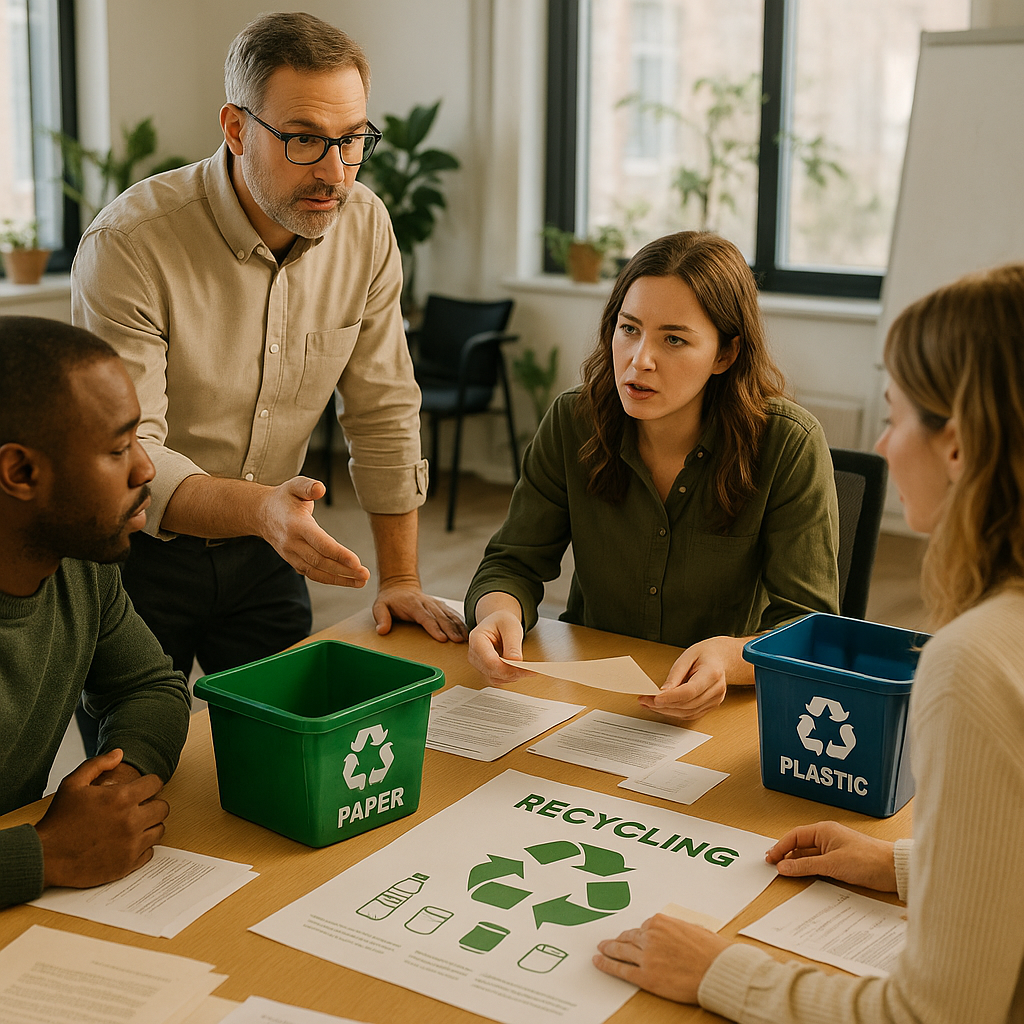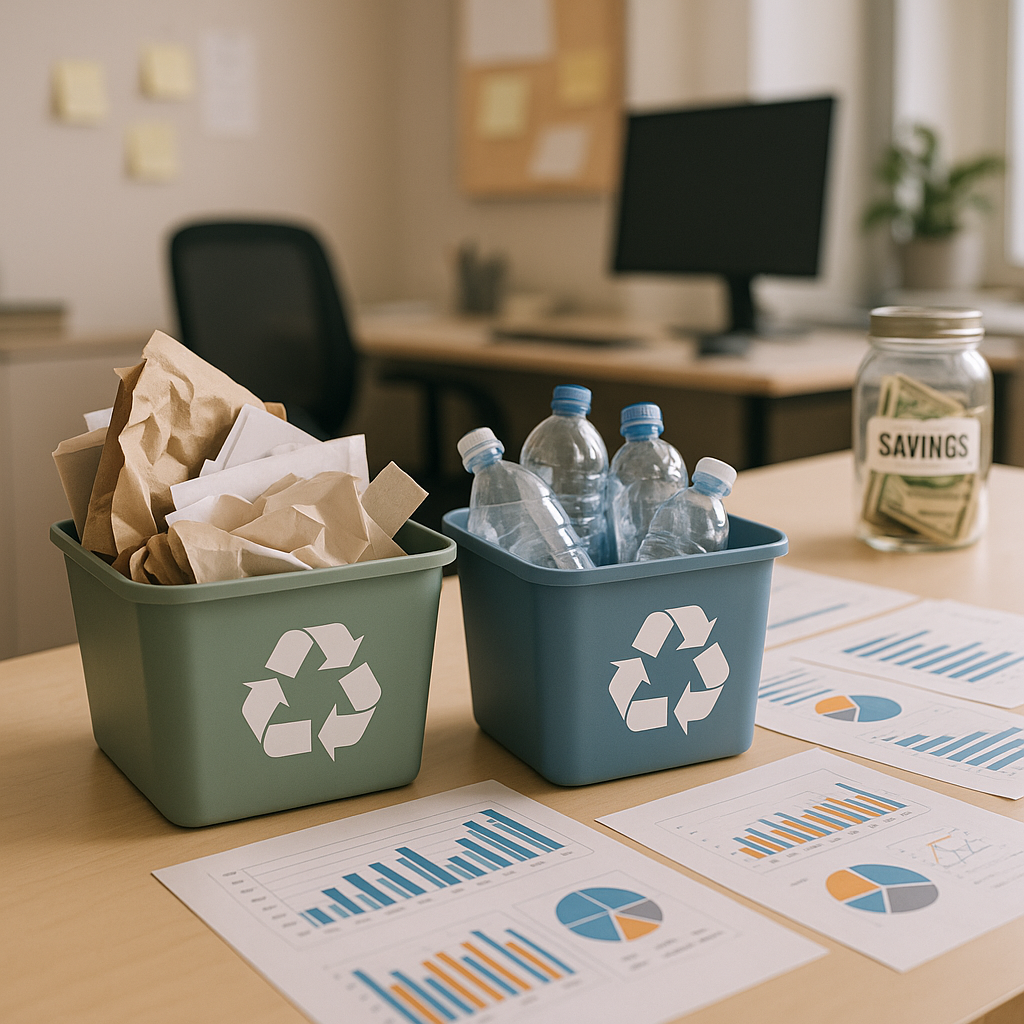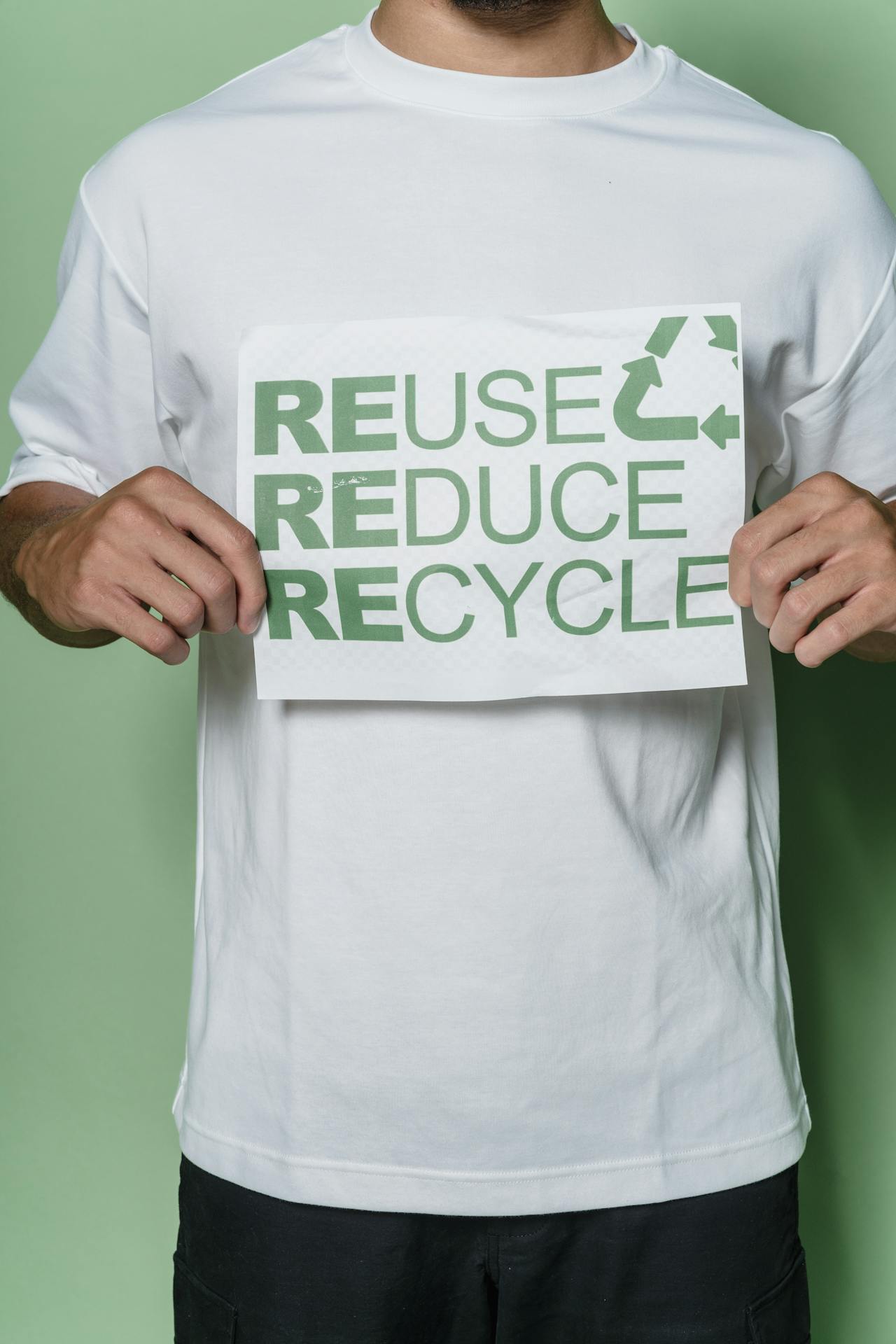5901 Botham Jean Blvd, Dallas, TX 75215
How to Start a Workplace Recycling Program
July 10, 2025A workplace recycling program is a structured initiative aimed at reducing waste within business environments by properly sorting and processing recyclable materials. These programs establish systems for collecting, sorting, and disposing of items like paper, plastic, glass, and electronics that would otherwise end up in landfills.
At its core, a workplace recycling program changes how businesses handle waste. Instead of traditional single-stream disposal, these programs implement designated collection points throughout the office. This fosters a workplace culture that emphasizes environmental responsibility and resource conservation.
The most effective workplace recycling programs do more than just place recycling bins around the office. They provide clear guidelines, employee education, and measurable goals to track progress. Companies with successful recycling initiatives often integrate these practices into their broader corporate sustainability strategies to enhance environmental benefits.
How Do You Plan a Workplace Recycling Program?

Establishing an effective workplace recycling program requires thoughtful planning and organization. Success depends on clear communication, proper infrastructure, and ongoing management. Here’s how to build a recycling program that works for your business.
Secure Management Support
The first critical step is gaining support from senior leadership. Management approval ensures you’ll have the necessary resources, budget, and authority to implement the program effectively. Make your case by highlighting potential cost savings from reduced waste disposal fees and emphasizing environmental benefits.
When approaching management, present a clear business case that includes potential waste diversion rates, estimated cost savings, and alignment with corporate sustainability goals. Leadership buy-in is crucial, as employees are more likely to participate when they see the program has official company backing.
Appoint a Recycling Coordinator
Every successful recycling program needs a dedicated champion. Designate a recycling coordinator or form a green team to lead your initiative. The ideal coordinator should be enthusiastic about sustainability, possess strong organizational skills, and communicate effectively.
Your coordinator will oversee program development, monitor progress, address questions, and serve as the main contact for recycling service providers. In larger organizations, consider establishing a green team with representatives from various departments to share responsibilities and build broader support.
Conduct a Waste Audit
Before launching your program, assess what’s in your trash. A waste audit helps identify recyclable materials your business generates in significant quantities. This step reveals opportunities for waste reduction and provides baseline data to measure your program’s success.
To conduct a basic waste audit, examine trash containers throughout your facility and note common items. Focus on high-volume materials like paper, cardboard, aluminum cans, and plastic bottles. Identify waste generation points such as copy centers, break rooms, and individual workstations.
Determine Which Materials to Recycle
Based on your waste audit findings, decide which materials your program will target. Start with high-volume recyclables that have established markets in your area. Common workplace recyclables include:
- Office paper and cardboard
- Aluminum cans and plastic bottles
- Glass containers
- Electronics
- Printer cartridges
Focus on materials that make up the largest portion of your waste stream and have reliable recycling outlets in your region. Check local regulations to ensure compliance with any mandatory commercial recycling requirements.
Contact Recycling Haulers
Research recycling service providers in your area. Start by contacting your current waste hauler to see if they offer recycling collection services. If not, search for specialized recycling companies that serve businesses.
When selecting a hauler, inquire about collection frequencies, acceptable materials, contamination policies, and pricing structures. Some questions to consider include whether they provide bins, how materials should be sorted, and what kind of reporting they offer on materials collected.
Set Up Your Collection System
Design a collection system that makes recycling convenient for employees. The easier your system is to use, the higher participation rates you’ll achieve. Consider these key components:
Place recycling bins in strategic locations throughout your workplace. Each desk might have a small recycling container, while common areas need larger bins. Always position recycling containers next to trash bins to reduce contamination. Use clear labels with both text and images showing which materials belong in each bin.
Determine how materials will move from individual collection points to your central storage area. Will custodial staff handle this, or will employees bring recyclables to central collection points? Establish a system that works with your existing operations and staffing.
Educate Employees
Even the best-designed recycling program will fail without proper education. Create clear, simple guidelines about what can and cannot be recycled. Train employees through meetings, emails, posters, and hands-on demonstrations.
Address common misconceptions about recycling and explain why contamination hinders the program. Provide regular updates and reminders to maintain awareness and participation. Recognize and reward departments or individuals who demonstrate exceptional recycling practices.
The success of your workplace recycling program depends on making it convenient, providing clear information, and maintaining consistent management support. With thoughtful planning and implementation, your program can reduce waste costs while contributing to environmental sustainability.
What Materials Can Be Recycled in the Workplace?

Office environments generate a surprising amount of recyclable waste. Paper products usually make up the largest portion, with office paper, newspapers, magazines, and cardboard boxes being universally recyclable. These materials are often clean and easily sorted, making them ideal candidates for recycling programs.
Paper and Cardboard
Office paper is among the most common recyclable materials found in workplaces. This includes printing paper, notepads, envelopes, and file folders. Newspapers, magazines, and catalogs can also be recycled through standard collection systems.
Cardboard from shipping boxes and packaging materials represents another significant recyclable stream. Many businesses receive regular deliveries, creating a steady flow of corrugated cardboard that can be recycled rather than sent to landfills.
When setting up paper recycling, place dedicated bins near printers, copiers, and in mailrooms where these materials are most frequently generated. This proximity makes recycling convenient for employees.
Beverage Containers
Break rooms and cafeterias produce recyclable beverage containers daily. Glass bottles, aluminum cans, and plastic bottles (particularly #1 and #2 plastics) are widely accepted by recycling programs. These containers should be emptied and rinsed before recycling.
Metal containers beyond aluminum, such as steel and bi-metal containers, can also be recycled. Proper signage on recycling bins helps employees identify which containers qualify for recycling and reduces contamination.
Electronics and E-Waste
Electronic waste (WEEE) includes computers, printers, phones, and other office technology. These items contain valuable metals and components that can be recovered. Many states have regulations requiring e-waste recycling rather than disposal in landfills.
Toner and ink cartridges from printers and copiers should also be recycled. Many manufacturers offer take-back programs for these items, simplifying the recycling process for office managers.
Other electronics like DVD players, VCRs, digital video recorders, and devices with video displays are required to be recycled in some states. Check local regulations regarding e-waste disposal.
Additional Recyclable Materials
Beyond the common items, workplaces can recycle fluorescent light bulbs, which contain mercury and should never be disposed of in regular trash. Major appliances like refrigerators, water heaters, and air conditioners from facility operations are also recyclable.
Some specialized workplace settings may produce additional recyclable materials. Automotive businesses can recycle used motor oil, oil filters, and lead-acid batteries. Manufacturing facilities often generate scrap metal and industrial plastics that recycling programs can process.
Conducting a waste audit helps identify which recyclable materials are most prevalent in your specific workplace. This assessment allows you to tailor your recycling program to address your highest-volume waste streams first.
How Do You Implement and Maintain a Successful Recycling Program?
Effective Communication Strategy
Clear communication is crucial for a successful workplace recycling program. Start by distributing comprehensive guidelines to employees and janitorial staff, clearly outlining which materials can be recycled and which cannot, to prevent contamination.
Visual aids are important in reinforcing proper recycling habits. Use bright, eye-catching signage and labels to mark recycling bins throughout the facility. Place these markers at eye level with simple, direct instructions to avoid confusion.
Make recycling information accessible through various channels. Post guidelines on bulletin boards and your company intranet. Include recycling protocols in new employee onboarding materials to establish proper habits from day one.
Training and Education
Initial training sessions should be concise yet thorough. Schedule department-specific orientation sessions addressing the distinct waste streams in different workplace areas. Allow time for questions to clear up any confusion about sorting procedures.
Janitorial staff require special attention in training efforts. As these team members handle materials directly, they can significantly impact your program’s success. Ensure they understand what is recyclable and how to prevent cross-contamination between waste streams.
Consider appointing recycling coordinators within each department. These point persons can answer questions, manage the recycling team, and provide program oversight. Their presence creates accountability and offers employees a resource for recycling queries.
Maintaining Program Momentum
Even well-designed recycling programs need regular attention to maintain engagement. Schedule quarterly refresher sessions to address common issues and introduce any program updates, keeping recycling protocols top of mind.
Use company newsletters and emails to share regular updates about the program’s progress. Highlight specific achievements, such as the amount of material diverted from landfills or cost savings achieved through recycling efforts.
Monitor contamination rates and participation through regular waste audits. These assessments help identify problem areas and inform program adjustments. Track quantifiable metrics and share these with employees to demonstrate the tangible impact of their participation.
Creating a Culture of Participation
Recognition programs significantly boost recycling participation. Acknowledge individuals or departments that consistently demonstrate excellent recycling practices. Small incentives or public appreciation in company communications can maintain enthusiasm for the program.
Make recycling convenient by placing collection bins in strategic locations. Position paper recycling containers near printers and copiers. Place commingled recycling bins in break rooms and eating areas. The easier you make recycling, the higher the participation rates will be.
Celebrate program milestones and successes publicly. When employees see the positive impact of their collective efforts, they develop a stronger commitment to recycling initiatives. These celebrations reinforce the program’s importance and recognize employee contributions.
Continuous Improvement
Establish feedback mechanisms allowing employees to share suggestions for program improvements. Simple surveys or suggestion boxes near recycling stations facilitate input. Acting on employee feedback demonstrates management values their insights and fosters shared program ownership.
Regular evaluation helps identify expansion opportunities. Consider adding new materials to your recycling stream as local capabilities evolve. Many programs start with basic materials like paper and cardboard before expanding to include plastics, glass, and electronics.
Connect individual actions to measurable environmental benefits to sustain long-term engagement. Quantify recycling efforts’ impact in concrete terms, such as trees saved or landfill space preserved. These tangible outcomes help employees understand why their participation matters.
What Are the Benefits and Challenges of Workplace Recycling?

Benefits of Workplace Recycling
Workplace recycling programs offer substantial financial benefits for organizations of all sizes. By diverting materials from landfills, companies can significantly reduce their waste disposal costs, with many businesses reporting up to 30% savings on waste management expenses after implementing comprehensive recycling initiatives.
Besides reducing costs, recycling can generate revenue. Companies can sell recyclable materials such as paper, cardboard, glass, and metals to recycling facilities. The automotive, construction, and packaging industries, in particular, benefit from selling scrap materials that would otherwise be discarded.
Enhancing corporate image is another key advantage. Businesses with strong sustainability programs appeal to environmentally conscious customers and investors. This commitment to environmental stewardship becomes a competitive advantage when attracting clients and partners who value green initiatives.
Employee Engagement and Workplace Culture
Recycling programs foster a positive workplace culture and improve employee morale. Staff members involved in environmental initiatives often report higher job satisfaction and a stronger connection to their workplace. This increased engagement frequently leads to improved productivity and reduced turnover rates.
Companies prioritizing sustainability also attract top talent. Many recent graduates and experienced professionals seek employers whose values align with their environmental concerns. A well-structured recycling program signals that an organization takes corporate social responsibility seriously.
Workplace recycling initiatives also drive innovation in other business areas. Once companies experience the benefits of sustainability in waste management, they often identify further opportunities to reduce their environmental footprint through process improvements, energy conservation, and product redesign.
Common Challenges in Workplace Recycling
Despite the benefits, implementing effective recycling programs presents several challenges. Initial setup costs can be significant, including purchasing recycling bins, creating signage, and potentially redesigning waste collection areas. Small businesses with limited budgets may find these startup expenses particularly difficult to cover.
Contamination is one of the biggest obstacles to successful recycling programs. If non-recyclable items end up in recycling bins, entire batches can be rejected by processing facilities. This issue often arises from confusion about recyclable materials, underscoring the need for clear, consistent education.
Maintaining consistent participation across departments and over time can be challenging. Initial enthusiasm often diminishes without regular reminders and reinforcement. This drop in participation can significantly reduce the program’s effectiveness and return on investment.
Overcoming Implementation Challenges
Successful workplace recycling programs begin with thorough waste audits. Understanding the types and volumes of waste generated helps companies design targeted initiatives to address their specific needs. This analysis reveals which materials offer the greatest recycling potential and which areas produce the most waste.
Employee education is the cornerstone of effective recycling programs. Clear guidelines, strategically placed signage, and regular training sessions help staff understand what can be recycled and how to prepare materials properly. Visual aids notably improve compliance by making instructions readily understandable.
Strategic bin placement significantly impacts participation rates. Recycling stations should be conveniently located in high-traffic areas and where specific recyclables are generated. For example, paper recycling bins belong near printers and workstations, while food and beverage container recycling is suitable for break rooms.
Measuring Success and Continuous Improvement
Establishing meaningful metrics helps organizations track program effectiveness and identify improvement opportunities. Key performance indicators include diversion rates, contamination levels, cost savings, and employee participation percentages. Regular monitoring of these metrics enables companies to make data-driven adjustments.
Recognition programs motivate continued participation in recycling initiatives. Departments or individuals who demonstrate exceptional commitment can receive acknowledgment through company newsletters, award ceremonies, or small incentives. Some organizations create friendly competitions to boost engagement across teams.
Regular communication about program achievements maintains momentum and illustrates the value of collective efforts. Sharing metrics such as pounds of material diverted from landfills or equivalent environmental impacts helps employees understand how their daily actions contribute to larger sustainability goals.
Conclusion: Building a Sustainable Workplace Through Recycling

Starting a workplace recycling program is a powerful step toward environmental responsibility. This journey, from initial planning through implementation to long-term maintenance, creates ripple effects that extend beyond simple waste diversion. Well-designed recycling programs reduce disposal costs, conserve valuable resources, and help companies meet their sustainability goals.
When businesses commit to recycling, they demonstrate environmental leadership that resonates with employees, customers, and the community. The most successful programs combine clear signage, convenient collection systems, regular education, and ongoing monitoring. Creating a culture of sustainability requires consistent communication and recognition of participation. By engaging employees as active participants, you build a workplace where environmental responsibility becomes second nature.
Ready to transform your workplace through recycling? Contact Okon Recycling at 214-717-4083 for expert guidance on implementing an effective recycling program tailored to your specific needs.
